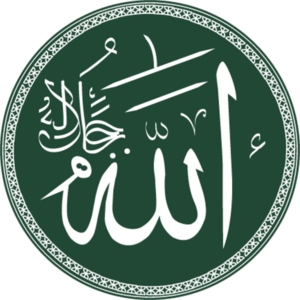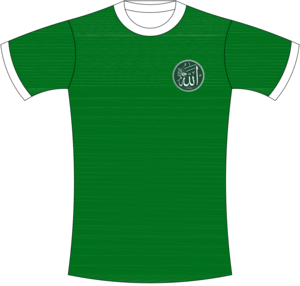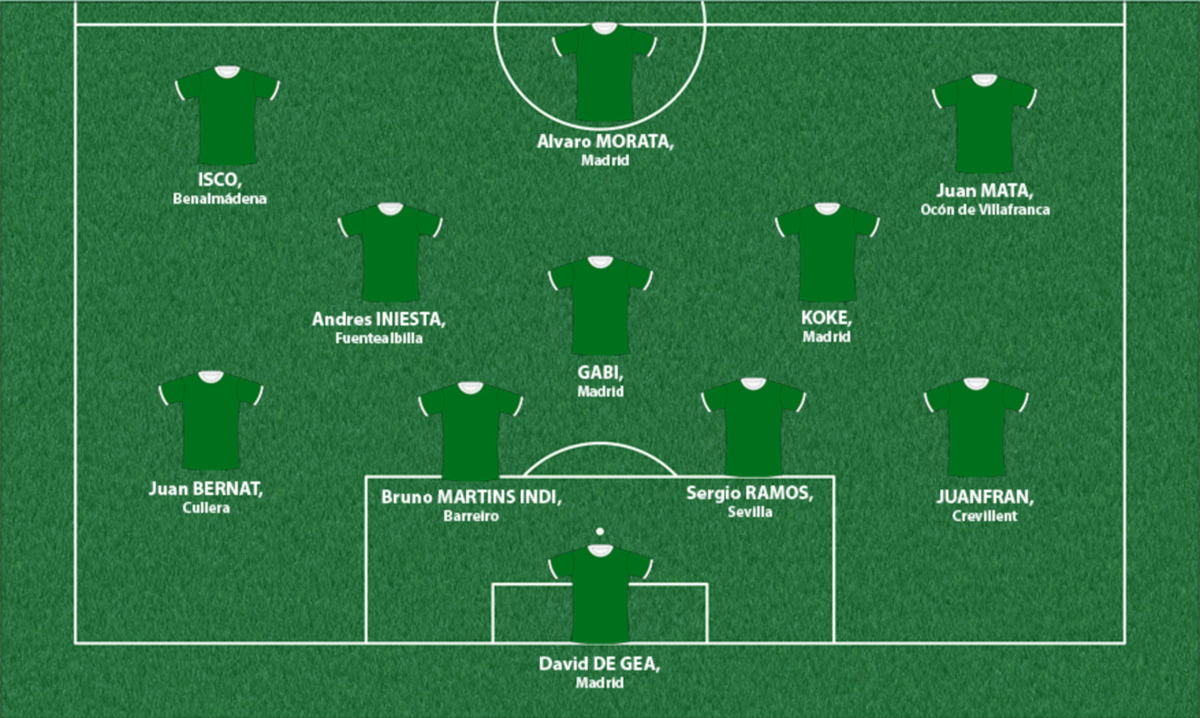The Emirate of Cordoba
The Emirate of Córdoba was an independent islamic emirate in the Iberian Peninsula that was founded after collapse of great Umayyad Caliphate.

Coat of arms

Shirt
| Position | First name | Last name | Mjesto rođenja | Like | Dislike | |
|---|---|---|---|---|---|---|
| GK | David | DE GEA | Madrid |
24 |
5 |
|
| GK | Iker | CASILLAS | Móstoles |
16 |
0 |
|
| GK | Sergio | RICO | Sevilla |
1 |
3 |
|
| DC | Jesus | VALLEJO | Zaragoza |
6 |
2 |
|
| DC | Raul | ALBIOL | Vilamarxant |
5 |
2 |
|
| DRC | Sergio | RAMOS | Sevilla |
19 |
5 |
|
| DLC | Bruno | MARTINS INDI | Barreiro |
7 |
3 |
|
| DRL/MR | Nelson | SEMEDO | Lisbon |
7 |
0 |
|
| DR | Daniel | CARVAJAL | Leganes |
16 |
4 |
|
| DR | Torres Belén | JUANFRAN | Crevillent |
4 |
1 |
|
| DR/MR | Joao | CANCELO | Setubal |
2 |
1 |
|
| DL | Jose Luis | GAYA | Pedreguer |
4 |
0 |
|
| DLC/ML | Marcos | ALONSO | Madrid |
11 |
0 |
|
| DL/ML | Juan | BERNAT | Cullera |
3 |
1 |
|
| DMC | Dani | CEBALLOS | Utrera |
4 |
1 |
|
| DMC | Gabriel Fernández Arenas | GABI | Madrid |
4 |
1 |
|
| MC | Andre | GOMES | Vila Nova de Gaia |
7 |
1 |
|
| MC | Andres | INIESTA | Fuentealbilla |
19 |
1 |
|
| MC | Joao | MOUTINHO | Portimao |
6 |
0 |
|
| MC | Renato | SANCHES | LISBON |
10 |
3 |
|
| MRLC | Jorge Merodio | KOKE | Madrid |
8 |
0 |
|
| MRLC | SAUL | Niguez | Elche |
9 |
0 |
|
| AMRLC | Bernardo | SILVA | Lisbon |
11 |
0 |
|
| AMRLC | Francisco Román Alarcón Suárez | ISCO | Benalmádena |
12 |
0 |
|
| AMRLC | Jesús Joaquín Fernández | SUSO | Cádiz |
5 |
0 |
|
| AMRLC | Juan | MATA | Ocón de Villafranca |
10 |
0 |
|
| AMRL | Gonacalo | GUEDES | Benavente |
8 |
0 |
|
| FRLC | Diego | NOLITO | Sanlúcar de Barrameda |
5 |
0 |
|
| FRLC | Giovanni | SIMEONE | Madrid |
2 |
1 |
|
| FRLC | Jose | CALLEJON | Motril |
4 |
1 |
|
| FRLC | MUNIR | El Haddadi | El Escorial |
5 |
1 |
|
| FC | Alvaro | MORATA | Madrid |
11 |
1 |
|
| FC | Fernando | TORRES | Madrid |
9 |
0 |
Today part of: central and southern Portugal, central, southern and eastern (without Catalonia) Spain
Religious fervor and advanced scientific discoveries enabled the successors of the Prophet Muhammad to establish a Caliphate which, in the mid-8th century, spread from the Iberian Peninsula, across northern Africa, towards the east, all the way to Afghanistan. However, during the 8th and 9th centuries, the unity of the great Caliphate broke, and various Arab states emerged. Back in the 8th century, the Sunni Umayyad dynasty rose to rule the territory of the old Roman province of Hispania, with their seat in Cordoba, which later gained its independence. Only in the small territories in the northern Iberian Peninsula, a few weak Christian kingdoms remained. Although the Muslim conquerors had not shown interest in converting the Christian and Jewish population, whom they treated with tolerance, the elites started converting to Islam, and by the 10th century, the Umayyad state epitomized a predominantly Muslim society. The Islamized population was known as the Moors, which in classical antiquity was the term used for the Berber people, who inhabited the areas of north-western Africa. Domestic inhabitans, especially in cities, accepted religion afrom conquerors. It was a gradual process and it is difficult to estimate its proportions. Both the convert and the Christians have adopted the use of Arabic in their daily lives, thus, in the Castilian language, so many Arabic words, toponyms, etc. The major importance was nearness of Gibraltar, towards North Africa, the source of political power, wealth, recruits and slaves. The gold traveled over the Sahara from the far Timbuktu. But Africa could also be a source of Berber and Islamist zeal. In general, the weakness of Islam was in the absence of internal religious and political unity.
The Umayyad state will be shaken by inner political and religious conflicts at the beginning of the 11th century, which will soon lead to its dissolution into a series of smaller emirates, and Cordoba will have to to cede its primacy to Seville. Cordoba became one of the most powerful scientific and cultural centers in Europe, and the medieval Islamic world was the one where teachings and wisdom of classical antiquity were preserved, which were in most part forbidden and systematically destroyed by the Christian rulers in Europe, seen as how education there was mostly established around the teachings from the Bible. Due to these policies, the Arabs had achieved new knowledge in cartography, medicine, and philosophy, as well as mathematics and optics.
Sources
- Niall FERGUSON, Civilizacija: Zapad i ostali, Zagreb, 2012.
- Patrick GEARY, Mit o nacijama – Srednjovjekovno poreklo Europe, Novi Sad, 2007.
- Grupa autora, Povijest: Kasno Rimsko Carstvo i rani srednji vijek , knjiga V., Zagreb 2008.
- Christopher HITCHENS, Bog nije velik : kako religija zatruje sve što dotakne, Zagreb, 2008.
- Nikola SAMARDŽIĆ, Identitet Španije, Beograd 2014.
- ''Mauri'', http://www.enciklopedija.hr/natuknica.aspx?id=39549
- Coat of Arms:
- Cordobski emirat: https://en.wikipedia.org/wiki/Allah
